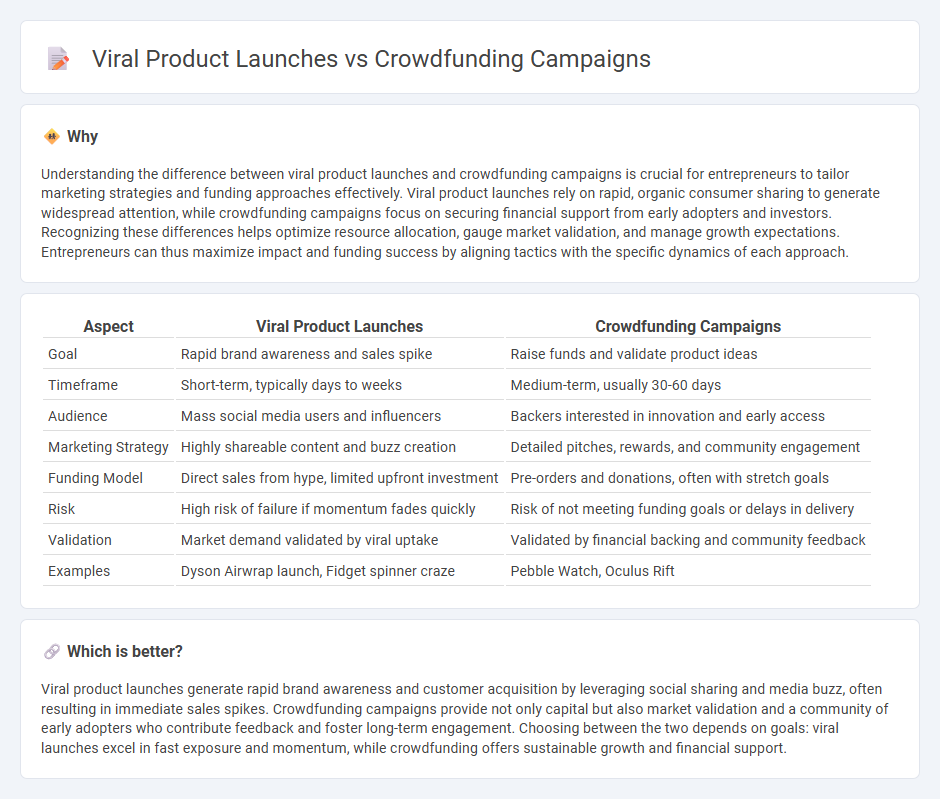
Viral product launches leverage rapid, organic sharing and social media momentum to create immediate consumer demand and widespread brand visibility. Crowdfunding campaigns focus on securing financial backing from a community of supporters while validating market interest and gathering early user feedback. Explore the key strategies and benefits of both approaches to maximize your entrepreneurial success.
Why it is important
Understanding the difference between viral product launches and crowdfunding campaigns is crucial for entrepreneurs to tailor marketing strategies and funding approaches effectively. Viral product launches rely on rapid, organic consumer sharing to generate widespread attention, while crowdfunding campaigns focus on securing financial support from early adopters and investors. Recognizing these differences helps optimize resource allocation, gauge market validation, and manage growth expectations. Entrepreneurs can thus maximize impact and funding success by aligning tactics with the specific dynamics of each approach.
Comparison Table
| Aspect | Viral Product Launches | Crowdfunding Campaigns |
|---|---|---|
| Goal | Rapid brand awareness and sales spike | Raise funds and validate product ideas |
| Timeframe | Short-term, typically days to weeks | Medium-term, usually 30-60 days |
| Audience | Mass social media users and influencers | Backers interested in innovation and early access |
| Marketing Strategy | Highly shareable content and buzz creation | Detailed pitches, rewards, and community engagement |
| Funding Model | Direct sales from hype, limited upfront investment | Pre-orders and donations, often with stretch goals |
| Risk | High risk of failure if momentum fades quickly | Risk of not meeting funding goals or delays in delivery |
| Validation | Market demand validated by viral uptake | Validated by financial backing and community feedback |
| Examples | Dyson Airwrap launch, Fidget spinner craze | Pebble Watch, Oculus Rift |
Which is better?
Viral product launches generate rapid brand awareness and customer acquisition by leveraging social sharing and media buzz, often resulting in immediate sales spikes. Crowdfunding campaigns provide not only capital but also market validation and a community of early adopters who contribute feedback and foster long-term engagement. Choosing between the two depends on goals: viral launches excel in fast exposure and momentum, while crowdfunding offers sustainable growth and financial support.
Connection
Viral product launches and crowdfunding campaigns share a powerful synergy, as viral marketing generates rapid awareness and engagement that drives funding momentum. Effective storytelling and social proof during a viral launch amplify trust, increasing backer confidence and financial support on crowdfunding platforms. The combined strategy leverages network effects to accelerate product validation, market penetration, and overall campaign success.
Key Terms
Backers
Backers in crowdfunding campaigns play a crucial role by providing early financial support and validating market demand, often receiving exclusive rewards or equity in return. In viral product launches, backers act more as enthusiastic promoters who amplify reach through social sharing and generate organic buzz without necessarily receiving direct incentives. Explore detailed strategies to engage backers effectively in both crowdfunding and viral product launch scenarios.
Virality
Virality in product launches significantly amplifies exposure through organic shares and word-of-mouth, creating exponential visibility beyond initial marketing efforts. Unlike crowdfunding campaigns that rely primarily on financial backing and targeted outreach, viral launches harness social media dynamics to rapidly reach diverse audiences. Explore how strategically leveraging virality can accelerate market penetration and customer engagement.
Incentives
Crowdfunding campaigns leverage early backer incentives such as exclusive rewards, limited editions, and discounted pricing to motivate contributions and create a committed community. Viral product launches prioritize shareability and social proof, often using referral bonuses, limited-time offers, and influencer endorsements to rapidly amplify reach and engagement. Explore detailed strategies to optimize incentives in both crowdfunding and viral marketing campaigns for maximum impact.
Source and External Links
15 Successful Crowdfunding Campaign Examples of the Decade - This article details 15 standout campaigns like Pebble Time which raised over $20 million by engaging existing communities, and YASHICA Vision that leveraged brand legacy and social media strategies to succeed on Kickstarter.
Crowdfunding: An Ultimate Guide for Individuals & Nonprofits - Provides examples of successful campaigns including the ALS Ice Bucket Challenge that used emotional appeal and viral marketing to raise $13,819, and Project Give which turned custom t-shirts into $3,000 for local homeless support.
20 Crowdfunding Campaigns That Will Meet or Exceeded Their Goal - Highlights diverse successful campaigns such as medical expense fundraisers like "Angie's Battle" for cancer treatment and large nonprofits like Habitat for Humanity's Global Village program using persuasive images and stories to mobilize support.
 dowidth.com
dowidth.com